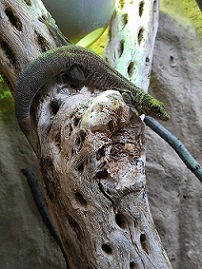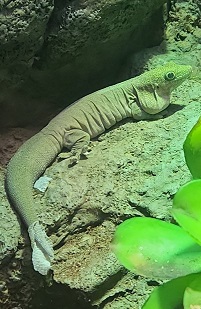Standing's Day Gecko
Phelsuma standingi
- Habitat: Dry forest and thornbush
- Range: South-western Madagascar
- Natural Diet: Insects and other invertebrates
- Status in the Wild:THREATENED
All about the Standings Day Gecko
Standings Day Geckoes are considered to be one of the largest species of day Geckoes. Their bodies are covered with scales and their color is a mottled bright green to turquoise and black. Their body sides and underbelly are pale brown in color. Their heads and bodies are bright green to turquoise in color. Their eyes are encircled with black. They have unique feet that have their undersurface lined with lamellae, a thin-plate tissue. Lamellae help day geckoes walk vertically and inverted on smooth surfaces such as glass. Lamellae also help geckoes in respiration.
Males and females look different from one another (sexually dimorphic). Males have distinguishable sex organs in their anal area. Females have chalk sacs on either side of their necks in which they store calcium that they use to build their eggs. They are 10 inches in length and they are very light (50 to 70 grams in weight).
Diet/ Habitat/ Range
Standings Day Geckoes are native to and only found in Madagascar living in dry forests and thornbrush. They are omnivores feeding on insects, other invertebrates, fruits, pollen, and nectar.
Behavior
Standings Day Geckoes are active during the day (diurnal) and live in trees (arboreal). Unlike mammals, geckoes cannot thermoregulate. They are often seen basking in the sun to warm up. Their body color helps them hide from predators in their natural habitat (camouflage). Males are highly territorial and they will fight with other males to protect their food resources and their females. Uniquely, it has been observed that females tend to display territorial displays against other females, an uncommon behavior for female geckoes.
Reproduction
Female Standings Day Geckoes lay eggs that hatch in two months. They sexually mature at one year of age.
Conservation/Status
Standings Day Geckoes are categorized as VULNERABLE by the World Conservation Union because of depleting population numbers mainly due to loss, degradation, and fragmentation of their habitat due to livestock grazing and slash-and-burn agriculture practices, collection for the international wildlife (pet) trade, and bushfires.

.jpg)
